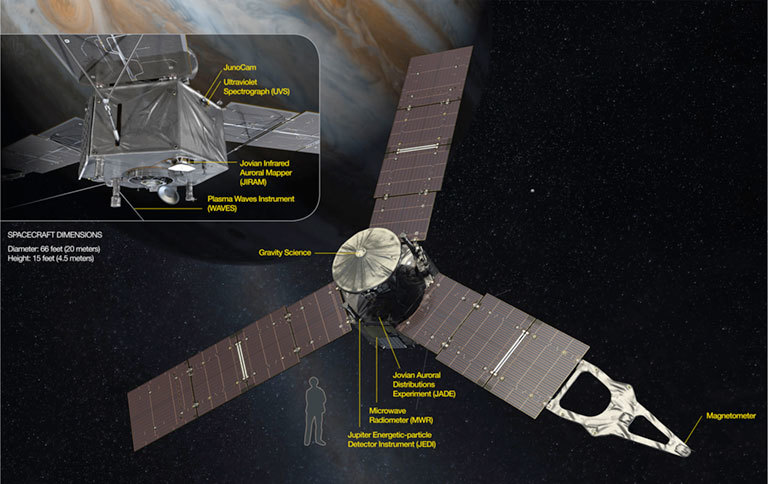News | August 31, 2011
Juno to Jupiter: On Its Way!

The Juno spacecraft carries a payload of 29 sensors, which feed data to nine onboard instruments. Eight of these instruments (MAG, MWR, Gravity Science, Waves, JEDI, JADE, UVS, JIRAM) are considered the science payload.
Juno, the second mission in NASA's New Frontiers Program†, launched flawlessly on Friday, August 5th, on a journey to Jupiter. It will be the first spacecraft to orbit Jupiter from pole to pole and peer far underneath the clouds. That cloud layer cloaks endless mysteries. It's amazing how much we don't know about our largest planet!
"Jupiter contains more mass than our other planets combined. In fact, if you put everything else in the solar system (with the exception of the sun) together it would fit inside Jupiter! So sizing up this behemoth will take us a long way toward understanding the solar system's formation."
Jupiter is a beautiful world - enormous and majestic, encircled with colorful bands like a marble. Is this decor just a surface meteorological effect like clouds here on Earth? Is the upper atmosphere just a thin skin covering the rest of a planet that is rotating underneath like a solid mass even though we know it's gaseous? Or perhaps there are concentric cylinders signifying something deeper and rotating in opposite directions.
The bands, called zones and belts, move at different speeds and do not appear to mix. And they're long lasting, so the roots must go way down. But how deep? And how deep is the Great Red Spot? It's lasted at least 300 years so it must be very deep! There might even be a core of heavy elements way down under all those stripes too. Juno will help us put these controversies to rest.
That's important. Jupiter contains more mass than our other planets combined. In fact, if you put everything else in the solar system (with the exception of the sun) together it would fit inside Jupiter! So "sizing up" this behemoth will take us a long way toward understanding the solar system's formation.
Jupiter hasn't changed much since the early solar system. Its composition is much like the early collapsing cloud composition, the stuff our solar system was made from. Juno will help us learn how this material manifested itself in this gas giant.
By learning about Jupiter's makeup we can learn about how our planet and its siblings came to be. Hydrogen, helium, and oxygen are the most common elements in solar system, and water is the most common molecule in heavy elements. (That's where the oxygen is usually found.) So we know that water played a tremendous role in forming the solar system. Juno will tell us about the water on Jupiter.
The spacecraft will fly just above the cloud tops for 33 orbits, measuring not only the composition of Jupiter's atmosphere, but also the planet's gravity and magnetic fields. Jupiter has a huge magnetosphere with a magnetotail that goes all the way to the orbit of Saturn! If everything works as planned, then Juno will give us the necessary insight to understand how the giant planet generates this dynamo.
Come with us as we make the journey to Jupiter with Juno to better understand our largest gas giant.
† New Frontiers is a hotly competed set of planetary missions for achieving goals defined by the Decadal Survey. The first New Frontiers mission, New Horizons, launched in 2006 and is headed for the Pluto-Charon system. The third New Frontiers mission, OSIRIS-REx, will capture an asteroid sample and return it to Earth.
